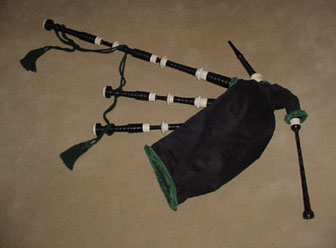The Bagpipes
One of the earliest written references to bagpipes is from around 100 AD, when Chrysostom wrote about the Emperor Nero, "They say that he can write, carve statues, play the aulos both with his mouth, and also with the armpit, a bag being thrown under it."

The bagpipe is found in many countries of the world including Scotland, Ireland, Russia, Finland, Germany, France, and Spain. Although the basic concept of the instruments is the same, these pipes take many different forms. Many scholars believe that the bagpipe was originally brought to Britain by the Romans. It has undergone many transformations over the centuries, until the Great Highland Bagpipe as we know it today finally evolved several centuries ago. There are four reeds in a Great Highland Bagpipe: the drones each have a cylindrical reed (cane or various synthetic materials, with a tongue which vibrates), and the chanter has a double reed (cane), similar to a bassoon or oboe reed, but shorter and much stiffer. The air for the reeds is supplied by the bag, filled by the piper blowing air through the blowpipe, and which has a built-in valve that closes when the piper takes a breath.
Greg's Kilgour & Kron Great Highland Bagpipes (pictured above) were made by Charley Kron in 1994. They are made from African Blackwood with imitation ivory mounts.
Greg's David Glen Great Highland Bagpipes date from the 1880s. They are made of Gaboon ebony with ivory mounts.